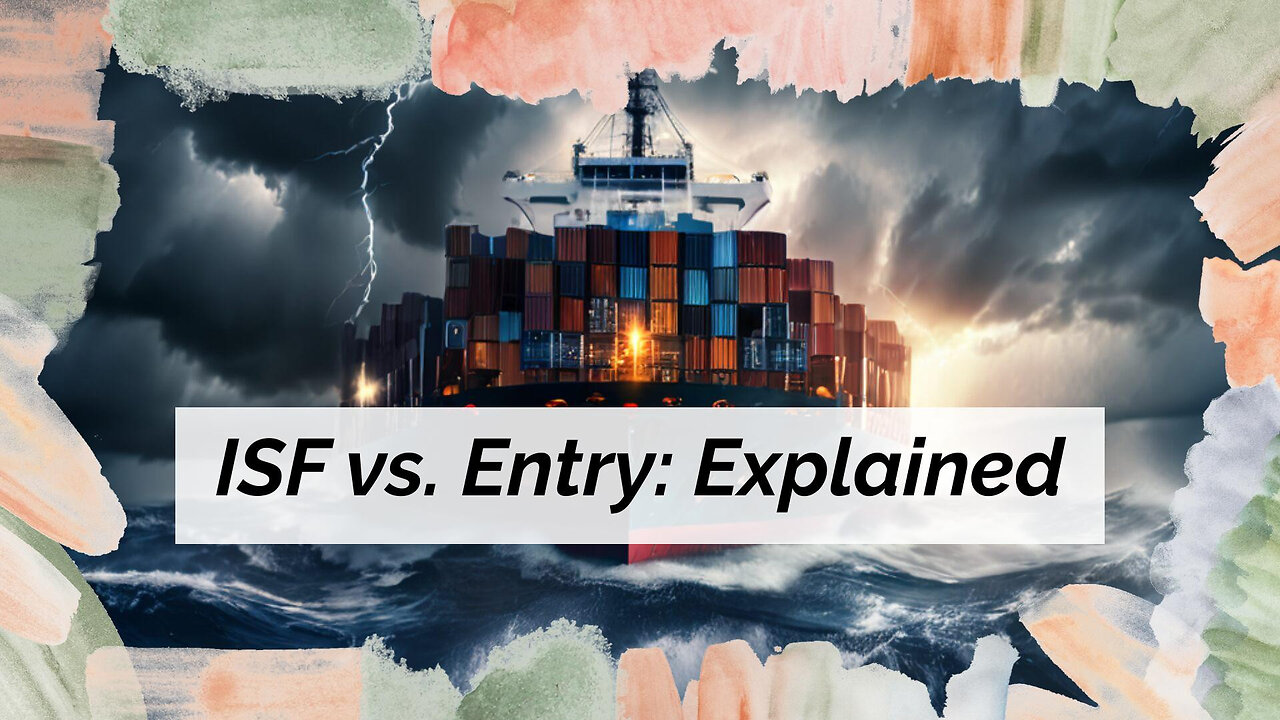Premium Only Content

Mastering ISF Filing vs Entry Filing: Understanding the Differences
ISF Solution | (832-904-9333)
clearance@isfsolution.com | www.isfsolution.com
Today's video provides a deep dive into the topic of Importer Security Filing (ISF) and its relationship with entry filing in the context of customs brokerage. ISF filing and entry filing are both critical aspects of the customs clearance process for imported goods as they aim to ensure compliance with import regulations and facilitate the smooth flow of goods across borders.
ISF filing, also known as 10+2 filing, is specifically required by the US Customs and Border Protection (CBP) for all ocean shipments entering the United States. It necessitates the submission of specific information about the cargo at least 24 hours before the departure of the vessel from the foreign port. On the other hand, entry filing entails the formal declaration of imported goods to the customs authorities and involves providing comprehensive details such as classification, value, and country of origin.
Although there is some overlap in terms of the information required, ISF filing and entry filing are distinct in their timing and purpose. ISF filing focuses on providing advance cargo information to enhance security and enable risk assessment, while entry filing serves as the formal declaration for clearance and assessment of duties and taxes.
To illustrate the relationship between ISF filing and entry filing, consider a scenario where electronic goods are being imported into the United States. The responsible party must submit the ISF filing, ensuring accurate information about the cargo before the vessel's departure. Once the vessel arrives at the US port, the licensed customs broker then proceeds with the entry filing, declaring specific details of the goods.
It is crucial to note that non-compliance with ISF filing or entry filing requirements can lead to penalties, delays, or even goods seizure. Therefore, importers and their authorized agents must prioritize the accurate and timely submission of both ISF and entry filings to ensure a smooth customs clearance process.
In conclusion, ISF filing and entry filing are distinct processes that contribute to the customs clearance of imported goods. Understanding the differences and requirements of each is essential for importers and their agents to comply with regulations and avoid potential complications. Stay tuned for more informative videos on customs brokerage and international trade.
#usimportbond #isfcustomsbroker #uscustomsclearing #isfentry
Video Disclaimer Here: For educational purposes - No affiliation with US government sectors.
00:35 ISF filing and entry filing are essential parts of the customs clearance process for imported goods, aiming to provide necessary information for compliance with import regulations and smooth border crossings.
00:5 - ISF filing (10+2 filing) is required by U.S. Customs and Border Protection for ocean shipments to the U.S., mandating specific cargo information submission at least 24 hours before vessel departure, while entry filing is the formal declaration of imported
goods to customs authorities after arrival in the destination country.
01:16 - ISF filing focuses on providing advance cargo information for security and risk assessment, while entry filing serves as the formal declaration for customs clearance, duty assessment, and inspections.
01:42 - Timely and accurate submission of both ISF and entry filings is crucial to avoid penalties, delays, or seizure of goods during the customs clearance process, emphasizing the importance of compliance for importers and their authorized agents.
-
 LIVE
LIVE
SpartakusLIVE
6 hours ago#1 HACKER gets UNBANNED || The MASSES Rejoice, The Accusers TRIGGERED
610 watching -
 54:33
54:33
Flyover Conservatives
22 hours agoThe #1 Mistake Singles Make That Keeps Them Alone Forever - Jackie Dorman | FOC Show
38K4 -
 1:06:32
1:06:32
PMG
22 hours ago $0.87 earned"372 Duodecillion Possibilities: COVID Complexities & Long COVID Remedies w/ Dr. Bryan Ardis"
17.1K5 -
 1:06:41
1:06:41
Donald Trump Jr.
10 hours agoDOGE Keeps Digging as Dems Keep Deceiving, Live with Lawyer Paul Moore & Entrepreneur Barry Habib | Triggered Ep. 216
132K79 -
 1:07:37
1:07:37
Slightly Offensive
4 hours ago $4.96 earnedTrump to FINALLY end UKRAINE WAR?! Putin AGREES | Nightly Offensive
49.1K22 -
 59:28
59:28
The StoneZONE with Roger Stone
5 hours agoTrump’s Divine Presidency: Pastor Randy Coggins II on Faith, Family, Freedom | The StoneZONE
41.9K4 -
 LIVE
LIVE
VOPUSARADIO
2 days agoPOLITI-SHOCK! SPECIAL 8 PM EST START! "TRANSFOMATIVE CHANGE IS COMING"! END THE FED!!
107 watching -
 1:08:03
1:08:03
Kimberly Guilfoyle
10 hours agoLIVE COVERAGE TRUMP-MODI MEETING | Ep.196
99.2K26 -
 1:26:45
1:26:45
Redacted News
8 hours agoPANIC in Germany: Scholz RAGES as Trump & Putin Push Ukraine Peace Deal, RFK CONFIRMED | Redacted
152K251 -
 1:58:14
1:58:14
Quite Frankly
10 hours ago"RFK's Moment, Gold Rush, Wendy Williams Shocker, MORE!" ft. Tony Arterburn, Lauren Conlin 2/13/25
30.4K5